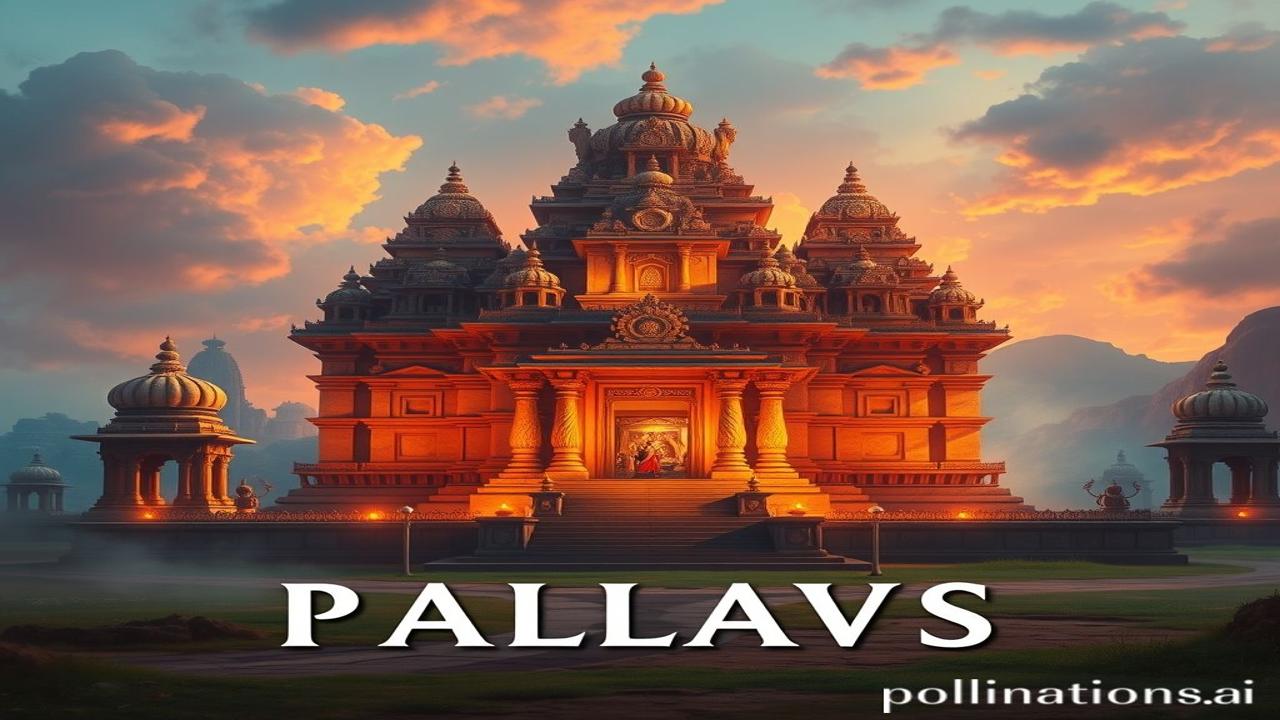Pallavas and their Temples: Patthar Bolte Hain…
Kabhi socha hai, in pathron mein bhi kahaniyan basti hain? Imagine, you’re standing before a towering temple in South India, the sun beating down, the scent of jasmine and sandalwood hanging in the air. You run your hand over the intricately carved stone, feeling the cool touch of ages gone by. Yeh pathar, yeh mandir, sirf eent aur pathar nahi hai. They whisper tales of kings, queens, artists, and devotees – the Pallavas and their magnificent temples. Waqt ki dhool mein chhupi hui ek anmol dastaan.
Pallava Dynasty: A Legacy Woven in Stone
The Pallavas. Who were they? Where did they come from? The Pallavas were a South Indian dynasty that flourished from the 3rd to the 9th centuries CE. They were powerful rulers who controlled a vast empire encompassing much of present-day Tamil Nadu, Andhra Pradesh, and parts of Karnataka. Their capital city was Kanchipuram, a vibrant center of learning and commerce.
Think of them as the OG architects of South Indian temple architecture. Before the Cholas and the Pandyas, it was the Pallavas who laid the foundation, both literally and figuratively. They transitioned from rock-cut cave temples to structural temples built from stone blocks. This was a massive leap in engineering and artistry! Their rule was not just about conquest and power, but also about fostering art, literature, and philosophy. They were patrons of Sanskrit, Tamil, and various forms of art, creating a unique cultural synthesis. And their temples? Woh toh unki shaan-o-shaukat ki misaal hain.
Zamini Sach: Mahendravarman, Narasimhavarman, aur Kala ke Diwane
Imagine Kanchipuram buzzing with activity. Mahendravarman I, the great Pallava king, is inspecting the construction of a new rock-cut temple in Mandagapattu. He’s not just a ruler, but an artist himself, personally overseeing the intricate carvings. “Yeh shilp, yeh kala, yeh Shakti ka prateek hona chahiye!” he declares, his voice echoing through the cavern.
Then picture Narasimhavarman I, also known as Mamalla, the conqueror of Vatapi. He’s overseeing the creation of the magnificent shore temples at Mahabalipuram. Warriors, artisans, priests – they all work together in harmony, driven by a shared vision. “Ma Rukmini ne aaj naye kapde pehne, kyunki mandir mein utsav tha…” The air is filled with the sound of chisels hitting stone, the chanting of mantras, and the laughter of children. Life revolves around the temple, it’s the heart of the community, a place of worship, learning, and celebration.
They weren’t just building temples; they were building a civilization, a culture. They were shaping the identity of the region, leaving behind a legacy that would endure for centuries. Their artisans, unsung heroes, poured their heart and soul into every carving, every sculpture, every detail. They dreamed of immortality through their art, and their dreams were etched in stone.
Dharohar aur Pehchan: Pallavas in Modern India
Today, we see the legacy of the Pallavas in the magnificent temples of South India, in the intricate sculptures, in the architectural styles that continue to inspire. The Shore Temple at Mahabalipuram, a UNESCO World Heritage Site, stands as a testament to their artistic genius. Kanchipuram, the city of thousand temples, still resonates with their spirit.
Their influence extends beyond architecture. The Bhakti movement, which emphasized devotion and love for God, gained momentum during their reign. The spread of Sanskrit and Tamil literature, the flourishing of art forms like dance and music – all these contribute to the rich tapestry of Bharatiyata. The Pallavas shaped the cultural landscape of South India, leaving behind a legacy that is deeply intertwined with our modern identity. Their dedication to art and culture reminds us of the importance of preserving our heritage and celebrating our past.
Majedar Tathya: Rock-Cut Wonders and the Mystery of the Shore Temple
Did you know that some of the earliest Pallava temples were rock-cut caves, carved directly into the hillsides? These were incredibly complex feats of engineering, requiring immense skill and precision.
And here’s a mystery: The Shore Temple at Mahabalipuram was actually buried under sand for centuries before being rediscovered in the 20th century! Imagine the stories it could tell!
Log samajhte hain ki all the Pallava temples are grand structures, lekin asli sach yeh hai ki they started with humble beginnings, small rock-cut caves, gradually evolving into the magnificent structures we see today.
Drishya aur Bhavnayein: The Temple Awakens
Imagine standing before the Kailasanatha Temple in Kanchipuram at sunrise. The air is cool and crisp, filled with the scent of incense and damp earth. The temple walls, made of sandstone, glow with a soft, golden light. You can feel the energy emanating from the ancient stones, the whispers of the past echoing in the air. The sounds of bells ringing, chants echoing in the distance, and the gentle breeze rustling through the palm trees create a symphony of sounds that transport you to another time. You touch the intricate carvings, the images of gods and goddesses, the scenes from epics, and you feel a connection to something larger than yourself, a sense of belonging to a rich and ancient heritage.
Antim Vichar: Ek Shlok, Ek Yaad
“Sarve bhavantu sukhinah, sarve santu niramayah, sarve bhadrani pashyantu, ma kashchid dukha bhag bhavet.” May all be happy, may all be free from illness, may all see what is auspicious, may no one suffer.
The Pallavas, through their temples, remind us of the power of art, the importance of devotion, and the enduring strength of the human spirit. Their legacy, etched in stone, continues to inspire and uplift us, connecting us to a glorious past and illuminating the path to a brighter future. Jaise pathar bolte hain, waise hi yeh kahani bhi hamesha zinda rahegi.
